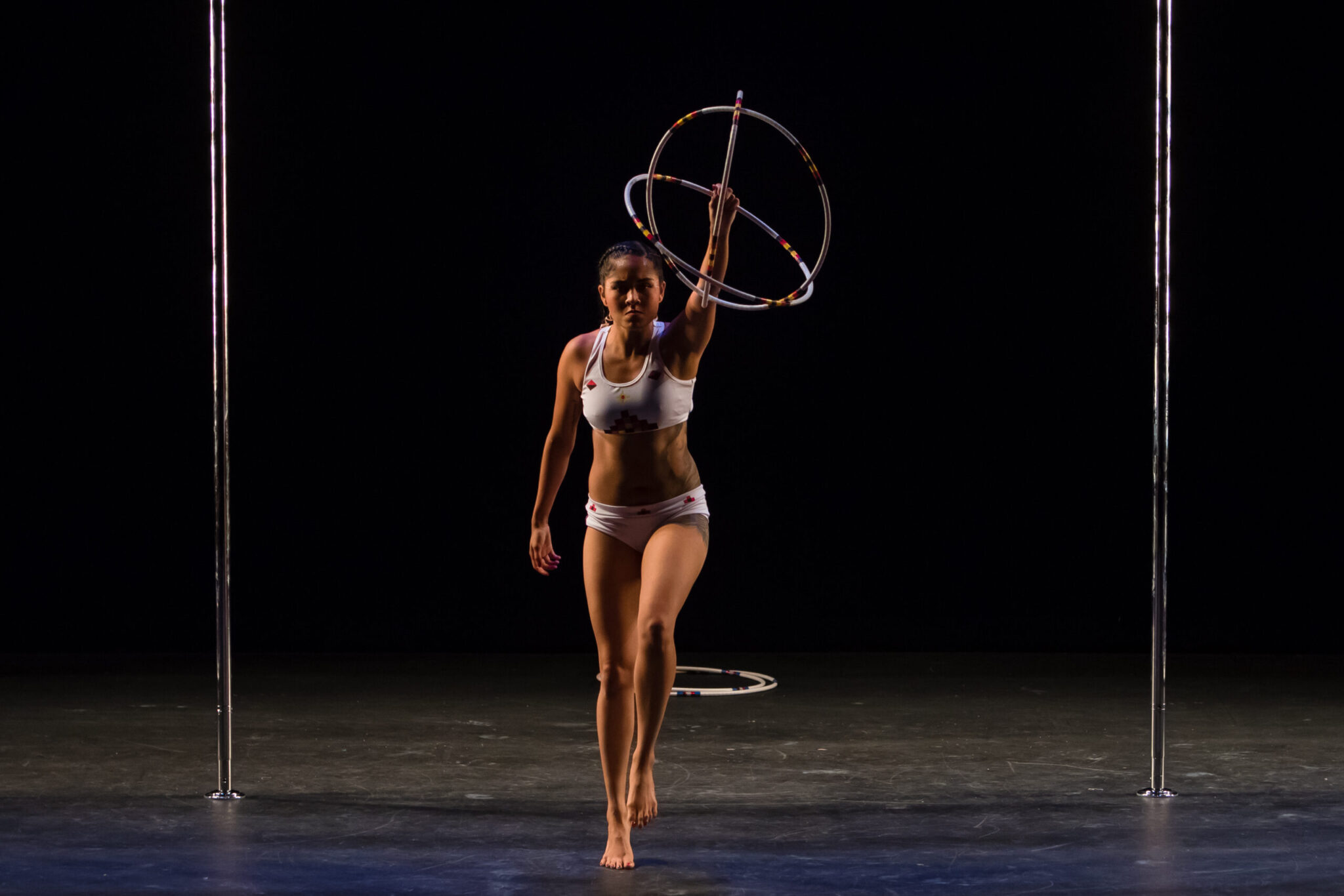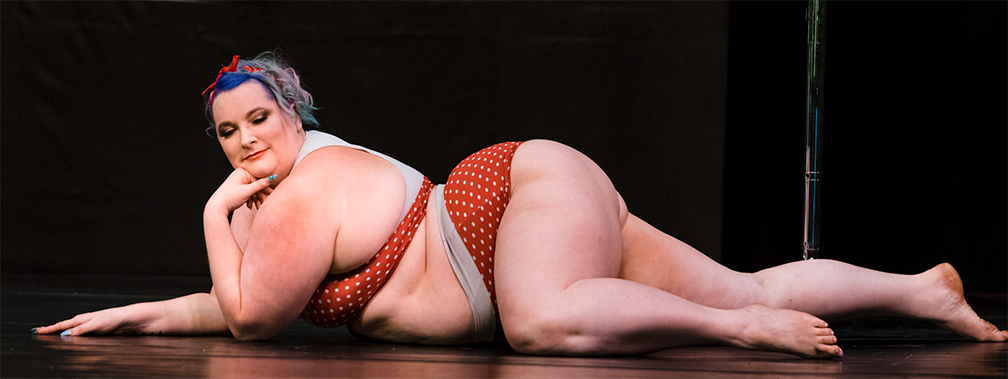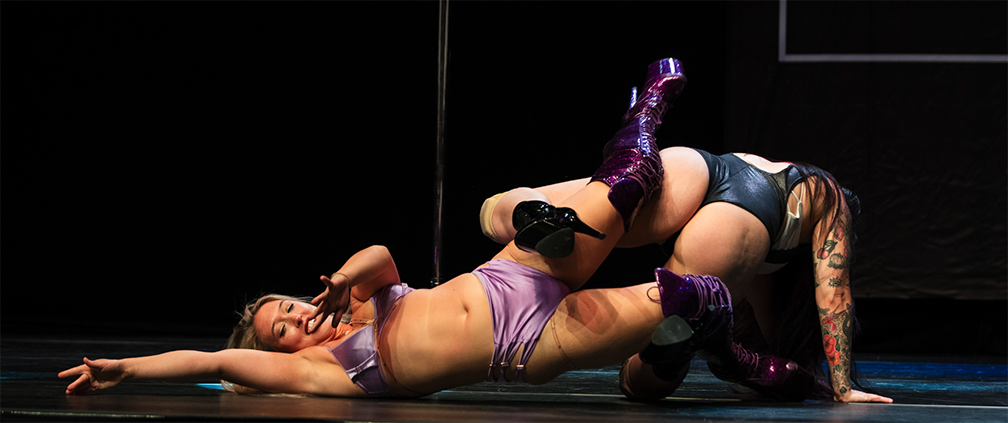
Appropriation of Native American/Indigenous Peoples and Culture in the Broader Pole Dance Community
Learn whose territories you reside on: Indigenous-Led Land Map
Indigenous artists to look to:
- Stripper, pole dancer and instructor Lynx Chase (IndigiFemme) @aylaylay_
- Editor, scholar and pole dancer Adrienne Huard aka Adrienne Loon (Anishinaabekwe) @adrienne_loon
- Bruja $xWrkr, $tripper/Advocate, Business Owner, Erotic Movement Specialist and published writer Nova Caine (Afro-Taína) @NovaCaineDances_llc
- International Nightlife Performer Blaine Petrovia @blainepetrovia
- Global Performer, Pole dancer, Cosplay, Contortionist Sin Twisted (Indigenous 2Spirit) @sintwisted
In the cousin practice of Burlesque:
- Indigenous troupe Virago Nation @viragonation
- Burlesque artist Lou Lou la Duchesse de Rière (Afro-Indigenous, Mohawk) @loulouladuchesse
The @ are used for Instagram and were shared with permission and how the artists identify. There are many impactful Indigenous artists and dancers out there in addition to those listed.
Intro: Oki niisto niitaniko, my name is Eva and I am of Native American (Aamskapipikuni Blackfeet, A’aninin GrosVentre, and Nakoda Assiniboine), Black, and Mexican mixed heritage. I come from a lineage of Weasel Head, Nickerson, Lopez-Hernandez families, who come from Indigenous territories in Montana and Canada, Wyoming and Colorado, and Sonora and Sinaloa. Each of my family lineages come with their own stories, ways of being, how they navigated the world, and ancestors who make me who I am today. I can’t speak from the Black experience in this country, which must be heard, amplified, and supported amid ongoing violence and racism against Black lives. I do exist from ancestors and generations of people, some of who were enslaved and exploited by settlers in the formation of what is known as the United States, but who were also among the first people here with their own creation stories, knowledges, and deep connection to the land. I exist alongside folks from these backgrounds with their own range of experiences, despite settler colonial efforts to wipe us out. Identifying with these backgrounds comes with responsibility, while understanding it as wholeness rather than dissecting who I am. I state this because naming my ancestors and generations before me is part of my Indigenous sense of being. As many Indigenous thinkers have written, our ancestors and previous generations are not simply part of the past, but with us always. Additionally, I state this for transparency of where I am speaking from, but also because the practice of stating up front who I am has been one I was taught from childhood from my Niitsitapi Aamskapipikuni (Blackfeet) relatives.
I write this with as much responsibility and care as possible and ask that you please hold space for any errors as I am still growing in my own process as a person and writer in this case. If you wish to reach out to me directly you may do so as well ([email protected]). Additionally, I cannot claim to speak for all Native American and Indigenous people, as Indigenous peoples have widely ranging beliefs, protocols, and ways of being. But I hope this offers perspective, some knowledge, and consideration regarding appropriation or creating something “inspired by” Native American and Indigenous people.
The conundrum: As I have worked on this, I find myself challenged in writing about the appropriation of the people I come from, my cultural background, and how this shows up in the broader pole community being as pole itself too is derived from and appropriated from Strippers, specifically Black Strippers who created the culture many in the pole community enjoy, participate in, or have capitalized on. I call for that to be acknowledged and that we pay, include, and support Strippers who have informed our practices in broader and local communities. And let me be clear, I write this acknowledging that Stripping is not a lived experience and profession that I can speak for, and I recognize that allyship in communities of Strippers and participants in pole may l look differently across the board. But as participants in pole, we have a responsibility to listen, support, and recognize Strippers who live/lived the profession and who invented, reinvent, and continue to impact pole dance as we know it today. *
So perhaps it is responsibility that leads me into the topic of cultural appropriation as it relates to Native American and Indigenous peoples. The issues of cultural appropriation of Native American and Indigenous peoples have deep ties to settler dehumanization used to justify land theft, genocide, murder, and ongoing racial violence that continues against our peoples today. I can say that this is not a new issue and in fact, there have been many Indigenous elders before me, and current Indigenous thinkers and activists adjacent to me who have fought long and hard on efforts for Land Back, Indigenous rights and sovereignty, bringing attention to Missing and Murdered Indigenous Women, Girls, 2 Spirit, Trans and Queer people, in addition to issues of appropriation. So for that, I exist in responsibility, gratitude, and relationship to my ancestors, elders, and present and future generations who in their existence enact resistance, brilliance, and defiance of all that settlers attempted to take from us.
*Instagram presences/orgs who advocate and do social justice work for Strippers and Sex Work communities include: @swopbehindbars Sex Worker Outreach Project, @soldiers_of_pole Soldiers of Pole, @pdxstripperstrike Stripper Strike PDX, @stilettosinc Philly Stripper Strike, @thebswc The Black Sex Worker Collective, @B.I.M.B.O.S (Black and Brown & Indigenous Mobilizing Beyond Oppressive Systems). Blog posts and articles to read: Sexual Sovereignty by Adrienne Huard and Jacqueline Pelland https://briarpatchmagazine.com/articles/view/sexual-sovereignty , Ahem… Dear Pleasers, We’re Upset by AMD https://www.thequeenofsexy.com/ahem-dear-pleasers-were-upset/
What I’ve witnessed in the broad pole community: Since my pole journey began in 2012, in addition to the blackface and yellowface (which is racist and problematic in itself), I have witnessed appropriation of Native American and Indigenous cultures across the pole community in person and online. I have seen the use of Plains headdresses (war bonnets), the use of the terms “tribe” and “spirit animal”, jokingly using our medicines i.e. sage and smudging, calling one’s self or dressing up as Pocahontas, wearing “war paint” and feathers reminiscent of or attempting to be the image of “Indian” or Native American. Each of the examples listed were done by non- Native or non-Indigenous people in a way that resembled harmful stereotypes derivative from violent and hateful relationships toward Native and Indigenous peoples, while romanticizing and simultaneously dehumanizing our people. I have also witnessed this appropriation show up or justified oftentimes in someone claiming to be “inspired by” Native American/Indigenous people. It should also be noted, the use of the prior named examples are also derived from real practices that are important to some Native American/Indigenous peoples. The use of headdresses and war bonnets, practices of face painting, use of medicines, and the use of feathers hold specific meaning and spiritual significance to specific Indigenous tribes. The true story of Pocahontas outside of the inaccurate and sanitized Disney depiction, was one that is actually quite tragic and painful (refer to Angela L. Daniel and George Custalow’s The True Story of Pocahontas). And the term “tribe” also comes with its own understanding and lived experiences to Indigenous peoples.
Our dances, languages, music, art, and spiritual beliefs were made illegal in this US and were punishable by corporeal violence in ways of withholding food/rations and physical abuses alongside directed efforts of family/child separation, hair cutting, murder, forced sterilization, and removal of Indigenous bodies. The named forms of corporeal punishment only scratch the surface of many violations against Indigenous life which continues into the present. It wasn’t until 1978 that our practices would be “legally” protected by the American Indian Religious Freedom Act. Our arts and cultural practices were made illegal in attempts to further remove us from our Indigeneity. In the US, there has been a history of legalized efforts to “Kill the Indian and Save the Man” by way of violent racialized tactics including genocide, boarding school institutions, medical sterilization, and making illegal what is important for us to survive and thrive. I bring this into the present tense because Native American, First Nations, and Indigenous people still face threats to sovereignty, their life, their bodies, and their land.
Appropriation: In writing to appropriation I draw from historian and anti-racist cultural worker and author Brenda Dixon Gottschild who in her work The Black Dancing Body: A Geography From Coon to Cool, speaks to Black dance in America, and Black dances/dancers as having a profound impact and central place in American dance. Gottschild grapples with the differentiation of appropriation “(or, less politely, a rip-off)” and exchange, and states appropriation as deeply connected to who’s got the power, “the power of the purse or the power of persuasion”. Gottschild states that because of white privilege, there is already a degree of power even in those “well-intentioned”. Although Gottschild acknowledges that there are undeniable relationships and mixtures of cultures in Black, Brown, Indigenous, and white people, given deep seated racism and white privilege, she argues that cultural borrowing exists on “grossly uneven ground”. From Gottschild’s work, I gather and extend appropriation in short form as taking and claiming from Black, Indigenous, People of Color, and Marginalized peoples while serving to benefit dominant culture and the “borrower” for personal and capital (social, financial, political, etc.) gain, without forms of exchange. Gottschild argues that without acknowledging or examining the issue we will not be able to transcend it. As people in this community we have a responsibility to acknowledge issues of appropriation, privilege, and racism in order to confront it, change, and move forward in solidarity.
Questions to consider in creating an “inspired by” piece: Is what you’re doing built from stereotyped and damaging depictions of Native American and Indigenous people? What tribe or people are you “inspired” by? In your process, did you learn from Native and Indigenous artists? Did you pay them? Did you maintain ethical and sustainable relationships? What is your piece going to do for Native American and Indigenous people or is this about your own benefit? Are you ready to receive critique from Native American and Indigenous people based on what you put into the world? Who did you learn from and what was your process in creating your piece?
These questions don’t serve as a definitive method for creating and performing, but rather points of consideration for furthering conversation and action.
Conclusion: If you are a non-Native or non-Indigenous person “inspired by” Native American/Indigenous peoples in creating your pole piece, please think deeply about what was shared here. Moving forward, please understand that learning about Native American/Indigenous peoples and their cultures, alongside many other cultures, is a commitment, which for some artists is a lifelong one that can involve the following:
- To actively support and listen to the community who you are drawing from.
- To learn/upkeep protocol of those you are working with.
- To be receptive to responsibility and criticism.
- To be prepared to consider if a community does not support you or does not want you to proceed.
- To give back in reciprocity and pay people.
- To consult with people in that community and gain multiple perspectives for a well-rounded understanding.
- To be prepared to respond to what you create, or have a conversation with those from communities you are drawing from as there are people who will want transparency for many valid reasons.
Terminology: I must address that as Native American and Indigenous people we are not a monolith despite what depictions based in stereotypes and limited history textbooks claim us to be. In the US these depictions have usually been centered around romanticization of settler expansion to the west, cowboy and Indian depictions, Indian Maidens, and stereotyped cartoon images to name a few. Terminology, language, and nations are important to Native American and Indigenous peoples. Currently, there are nearly 600 across federally recognized tribes across the country, and hundreds more who have not gained recognition or are seeking recognition. Additionally, some Native American, Indigenous and First Nations tribes share relationships, nations, and confederacies that were here long before and beyond “borders” created by colonizers between Canada and the US, and between Mexico and the US. Some Native American, Indigenous, and First Nations people prefer to be addressed by their tribal name, and in their language.
The terms “Native American” and “American Indian” were created categorizations but also specific terms related to federally recognized tribes in the US. These categorizations also impact the lived experiences of Native American people and tribal communities on and off reservations in the US. “American Indian” typically excluded Indigenous Native Hawaiian, Pacific Islanders, and Alaskan Natives as defined by the US census. The term “Indigenous” is also used in North America, and as Stephanie Nohelani Teves (Kanaka Maoli) describes in her book Defiant indigeneity: The Politics of Hawaiian Performance, Indigeneity in Kanaka Maoli understandings are about having a specific and special relationship with the land and nature. Teves furthers this by stating that it is the relationship to land that anchors claims to sovereignty, and also differs from settler relationships to land (Teves 14). Drawing from Teves alongside many Indigenous thinkers, I understand Indigenous peoples as the first peoples of their lands, with specific and sacred relationships to their land, with rights, rites, protocols, responsibilities, and creation stories as first peoples. Linda Tuhiwai Smith (Ngāti Awa and Ngāti Porou) has also written to the term Indigenous stating it “as a way of including… many diverse communities, language groups and nations”. Smith also mentions that this term can be problematic as it works to collectivize many populations under imperialism whose experiences are vastly different. In some parts of the world, it is dangerous for people to call themselves Indigenous and they may not use that term.
As Native American and Indigenous peoples in North America, our cultural practices are specific to each tribe, clan, community, and family. Federal recognition alongside blood quantum, should not delegitimize the Indigeneity of those not federally recognized, seeking recognition, or those not “full blooded”. This can open up a range of discussions, more than could be covered in this blog post, so I encourage you to continue to self educate from here. For more reference, Linda Tuhiwai Smith’s book Decolonizing Methodologies: Research and Indigenous Peoples writes to the term Indigenous in more depth.


